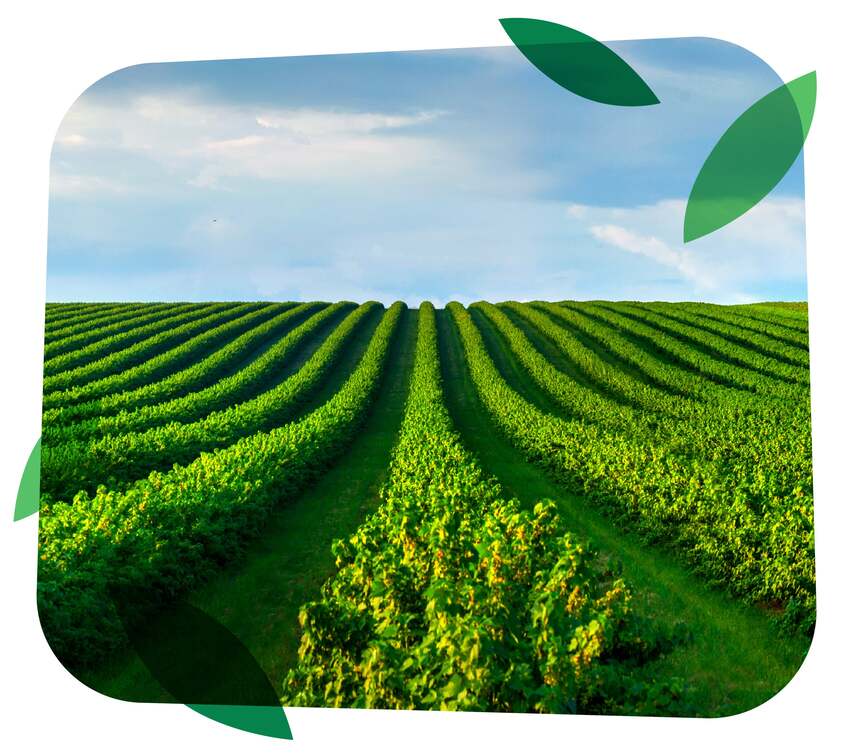Contents:
- Nutrient uptake curves
- Main functions of plant nutrients
- Nutritional disorders in potatoes
- Leaf analysis standards
- Plant nutrient requirements
2.1 Nutrient uptake curves
Nutrients uptake is at its greatest during tuber bulking up (intensive volume increase process).
The amount of nutrients removed by a potato crop is closely related to yield. Usually, twice the yield will result twice the removal of nutrients. Nutrients need to be applied as accurately as possible to the zone of uptake, slightly before, or at the time that the crop needs them. Failure to ensure that each plant gets the right balance of nutrients can spoil crop quality and reduce yield.
The highest requirement for potassium, as shown on Figure 4, is during the bulking up stage of the tubers. The flowering of potato plants is an indication when this morphological stage starts. Consequently, the ideal side-dressing period with Multi-K™ would be during the tuber bulking stage.
Figure 4: Uptake of macronutrient uptake by a whole potato plant
Source: Harris (1978)
The daily requirements of potato tubers during the critical bulking stage are 4.5 kg/ha N, 0.3 kg/ha P and 6.0 kg/ha K. Potassium requirements of potato tubers during the bulking stage are very high as they are considered to be luxury consumers of potassium. Daily yield increase during the critical tuber bulking stage can reach 1000 - 1500 kg/ha/day. Therefore, it is important to supply the required plant nutrients during the tuber bulking stage in right N-P-K ratio and in ample quantities.
Figure 5: Uptake of macro and secondary nutrients by vines and tubers of potato plants yielding 55 ton/ha
Source: Reiz, 1991
Figure 6: Uptake of micro-nutrients by vines and tubers of potato plants yielding 55 ton/ha
2.2 Main functions of plant nutrients
Table 1: Summary of main functions of plant nutrients
| Nutrient | Functions |
| Nitrogen (N) | Synthesis of proteins (growth and yield). |
| Phosphorus (P) | Cellular division and formation of energetic structures. |
| Potassium (K) | Transport of sugars, stomata control, cofactor of many enzymes, reduces susceptibility to plant diseases. |
| Calcium (Ca) | A major building block in cell walls, and reduces susceptibility to diseases. |
| Sulfur (S) | Synthesis of essential amino acids cystine and methionine. |
| Magnesium (Mg) | Central part of chlorophyll molecule. |
| Iron (Fe) | Chlorophyll synthesis. |
| Manganese (Mn) | Necessary in the photosynthesis process. |
| Boron (B) | Formation of cell wall. Germination and elongation of pollen tube. Participates in the metabolism and transport of sugars. |
| Zinc (Zn) | Auxins synthesis. |
| Copper (Cu) | Influences in the metabolism of nitrogen and carbohydrates. |
| Molybdenum (Mo) | Component of nitrate-reductase and nitrogenase enzymes. |
Table 2: Effects of the nutrients and the potassium source on the yield quality
| Parameter | Increase in dosage of | Application of KCl in comparison to chloride-free K (-Cl) | ||
| Nitrogen | Phosphorus | Potassium | ||
| Tuber size | ↑ | No effect | ↑ | Chloride-free K helps increasing size |
| Sensitivity to mechanical damage | ↑ | ↓ | ↓ | No information |
| Tuber blackening 1 | ↑
| No effect | No effect | KCl is more effective than (-Cl) |
| % dry matter 2 | ↓ | ↑Slight effect | ↑ | Some reports claim that heavy applications of KCl can result in a lower dry matter, this might be due to the chloride effect |
| % starch 3 | ↓ | ↑ | ↑ | Some reports claim that heavy applications of KCl can result in a lower dry matter, this might be due to the chloride effect |
| % protein | ↑ | ↓ | Conflicting results | Chloride-free K helps increasing content |
| % reducing sugars | Inconsistent | ↑ | ↓ | No difference |
| Taste | ↓ | ↑ | No effect | Chloride-free K is better |
| Blackening after cooking | ↑ | No effect | ||
1 Blackening is caused by oxidation of phenol compounds when skin is exposed.
2 A high percentage of dry matter is required in potatoes for industry.
3 High concentrations are desirable. The characteristic is correlated to the specific gravity.
Nitrogen (N)
Adequate N management is one of the most important factors required to obtain high yields(Fig. 7) of excellent quality potatoes. An adequate early season N supply is important to support vegetative growth.
Figure 7: The effect of nitrogen (N) on potato yields
Excessive soil N, applied late in the season delays maturity of the tubers and result in poor skin set, which harms the tuber quality and storage properties. Potatoes are a shallow-rooted crop, generally growing on sandy, well-drained soils. These soil conditions frequently make water and N management difficult since nitrate is susceptible to leaching losses. On these sandy soils, it is recommended that potatoes receive split applications of N during the growing season. This involves applying some of the total N requirement prior to planting and applying the remainder during the season with side-dress applications or through the irrigation system by Nutrigation™ (fertigation).
The period of highest N demand varies by potato variety and is related to cultivar characteristics, such as root density and time to maturity. Petiole analysis during the growing season is a useful tool, allowing growers to determine the N status of the crop and respond in a timely manner with appropriate nutrients.
A balanced ammonium / nitrate ratio is very important at planting time. Too much ammonium-nitrogen is a disadvantage as it reduces root-zone pH and thereby promotes Rhizoctonia disease. Nitrate-nitrogen enhances the uptake of cations such as calcium, potassium and magnesium, required for elevated specific gravity values.
Figure 8: Relative response of potato growth to the nitrate-ammonium concentrations in the nutrient solution
At 12 mM of N, plants exhibited interveinal ammonium toxicity with NH4+ nutrition, but healthy growth with NO3- nutrition. Thus, a careful control of NH4+ concentrations is necessary to minimize ammonium toxicity to potato plants.
Figure 9: Effect of Nitrate/Ammonium ratio and N rate on total yield of U.T.D. tubers
Source: Vegetables & Fruits, Feb./March, 2000. South Africa
Nitrogen Assessment
Soil testing to a depth of 60 cm. in the spring is critical to planning an effective and efficient N management program. Post-harvest soil samples may help growers to select succeeding crops, which will make maximum use of the residual N after the potato crop.
The nitrogen demand by the crop during tuber bulking may be 2.2 to 3.0 kg/ha/day. Petiole nitrate sampling allows for in-season monitoring of the crop’s nutrient status. Collecting the 4th petiole from 30 – 50 randomly selected plants throughout the field (Fig. 10) is recommended. Tissue samples are often collected weekly to track changes in nitrate levels, and to plan supplemental fertilizer applications, should levels drop below optimum.
Critical petiole nitrate-levels decline as the potato crop develops and matures. Generally, petiole nitrate-N levels at tuber bulking are <10,000 ppm = low, 10,000-15,000 ppm = medium, >15,000 ppm = sufficient. (Fig. 11)
Figure 10: The structure of the 4th leaf on a potato plant

Figure 11: Interpretation of N-NO3 levels in potato petioles at different stages of growth
Phosphorus (P)
Phosphorus is important for early root and shoot development, providing energy for plant processes such as ion uptake and transport. Roots absorb phosphate ions only when they are dissolved in the soil water. Phosphorus deficiencies can occur even in soils with abundant available P, if drought, low temperatures, or disease interfere with P diffusion to the root, through the soil solution. These deficiencies will result in stunt root development and inadequate function.
At the tuber initiation stage, an adequate supply of phosphorus ensures that optimum number of tubers is formed. Following the tuber initiation, phosphorus is an essential component for starch synthesis, transport and storage.
Recent research suggests that modifications to P fertilizer, such as polymer additives, humic substances, and coatings may be beneficial in improving P uptake and potato production.
Potassium (K)
Potato plants take up large quantities of potassium throughout the growing season. Potassium has an important role in the control of the plant water status and internal ionic concentration of the plant tissues, with a special focus on the stomatal functioning.
Potassium plays a major positive role in the process of nitrate reduction within the plant. Where large amounts (e.g. >400 kg/ha K2O) are to be applied, in temperate conditions it is advisable to split the dressings 6-8 weeks apart.
Potatoes require large amounts of soil K, since this nutrient is crucial to metabolic functions such as the movement of sugars from the leaves to the tubers and the transformation of sugar into potato starch. Potassium deficiencies reduce the yield, size, and quality of the potato crop. A lack of adequate soil K is also associated with low specific gravity in potatoes.
Potassium deficiencies impair the crop’s resistance to diseases and its ability to tolerate stresses such as drought and frost. Applying K fertilizer with a broadcast application prior to planting is most commonly recommended. If the K is band-applied, the rates should be kept below 45 kg K2O/ha to avoid any salt injury to the developing sprouts.
Selection of the best K fertilizer
The source of potassium plays an important role on the quality and the yield of potato tubers. By comparing different sources of K, Multi-K™ potassium nitrate was found to increase the dry matter ontent and the yield significantly higher than other sources of K (Fig. 12 & 13). This study was done on different cultivars and all of them responded with higher tuber yield to Multi-K™ treatment(Fig 14).
Figure 12: The effect of different potassic fertilizers on the potato tuber yield
Source: Reiz, 1991
Figure 13: The effect of different potassic fertilizers on the dry matter content in potato tubers
Source: Reiz, 1991
Figure 14: The effect of different potassic fertilizers on potato yield of various cultivars
Source: Bester, 1986
The potato's specific gravity and the chips color are important parameters for the processing potatoes industry. Both of these parameters are responding favourably to Multi-K™ potassium nitrate treatments as compared to other sources of K fertilizers (Fig. 15, 16).
Figure 15: The effect of different potassic fertilizers on chips color rating
Source: Reiz, 1991
Figure 16: The effect of different potassic fertilizers on specific gravity of potato tubers
Source: Reiz, 1991
Beside the favourable effect of Multi-K™ on the quality and yield of potato tubers, it also improves the shelf life of the tubers in storage (Fig. 17).
Figure 17: The effect of different K fertilizers loss of mass over time (@ 20oC, RH 66%)
Source: Bester (1986)
Calcium (Ca)
Calcium is a key component of cell walls, helping to build a strong structure and ensuring cell stability. Calcium-enriched cell walls are more resistant to bacterial or fungal attack. Calcium also helps the plant adapt to stress by influencing the signal chain reaction when stress occurs. It also has a key role in regulating the active transport of potassium for stomatal opening.
Magnesium (Mg)
Magnesium has a central role in photosynthesis, as its atom is present in the centre of each chlorophyll molecule. It is also involved in various key steps of sugar and protein production as well as the transport of sugars in the form of sucrose from the leaves to the tubers.
Yield increases of up to 10% were obtained in trials in which regular application of magnesium fertilizers has been practiced .
Sulphur (S)
Sulphur reduces the level of common and powdery scab. This effect is related to a reduction in the soil pH where sulphur is applied in its elemental form.
2.3 Nutritional disorders in potatoes
Nitrogen
Nitrogen deficiency is manifested by reduced growth pale leaves, and results in reduced tuber yield (size and number). The deficiency is made worse by extrenme soil pH (low or high), low organic matter, drought conditions or heavy irrigation (Fig. 18).
Nitrogen excess causes delayed maturity, excessive top growth, hollow heart & growth cracks, increased susceptibility to biotic diseases, reduced tuber specific gravity and difficulty in vine ‘burning’ before harvest.
Figure 18: Characteristic nitrogen (N) deficiency symptoms

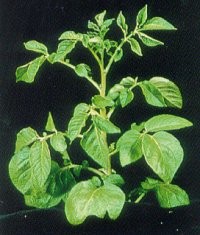
Phosphorus
Typical symptoms and syndroms related with phosphorus deficiency are: fewer tubers, smaller tubers, stunted plants, yellowing of older leaves, small dark green younger leaves (Fig. 19).P deficiency leads to reduced early vigor, delayed maturity and reduced yields.
Excessive phosphorus, when present, ties up other elements such as calcium and zinc, inducing thereby their deficiencies.
Figure 19: Characteristic phosphorus (P) deficiency symptoms

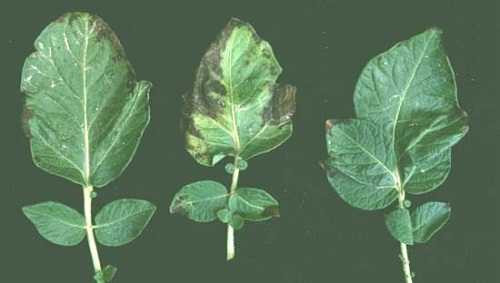
Potassium
Potassium deficiency retards nitrogen uptake, slows down plant growth and leads to reduced yields, inferior quality, and poor disease resistance. Typical symptoms of K deficiency are necrosis of leaf margins, premature leaf senescence (Fig. 20)
Excessive potassium causes reduced tuber specific gravity and reduced calcium and/or magnesium uptake. It also degrades soil structure.
Figure 20: Characteristic potassium (K) deficiency symptoms
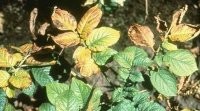
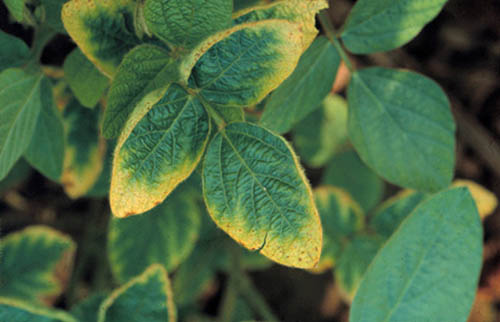
Calcium
Calcium deficiency interferes with root growth, causes deformation of foliage growth tips, and may result in reduced yields and poor quality. Calcium-deficient potato tubers have reduced storage capability. Low calcium levels in the soil result in poorer soil structure.
Typical symptoms of calcium deficiency are yellow curled leaves on upper leaves, tip burns, and small chlorotic new leaves. (Fig. 21)
Excessive calcium results in reduced magnesium uptake, with the symptoms related to magnesium deficiency.
Figure 21: Characteristic calcium (Ca) deficiency symptoms

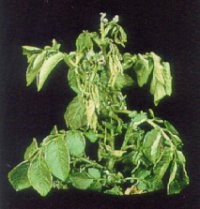
Magnesium
As magnesium is a key element in photosynthesis, its rate slows down under conditions of magnesium deficiency, resulting in Reduced tuber formation and lower yields. Severe magnesium deficiency can reduce yields by up to 15%. Magnesium-deficient tubers are more easily damaged during lifting and storage.
Typical deficiency symptoms: Leaves get yellow and brown; The leaves wilt and die; Stunted plants, early crop maturation; Poor skin finish of the tubers. (Fig. 22)
Excessive magnesium results in reduced calcium uptake, with the symptoms related to calcium deficiency.
Figure 22: Characteristic magnesium (Mg) deficiency symptoms
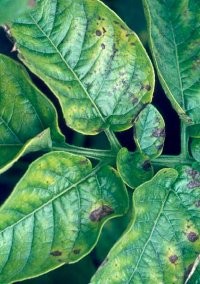
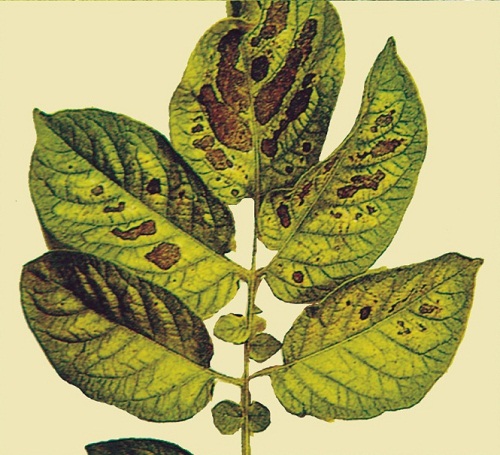
Sulfur
Sulfur (S) deficiency causes reduced growth, and leaves become pale green or yellow. Number of leaves is reduced. (Fig. 23)
Figure 23: Characteristic sulfur (S) deficiency symptoms
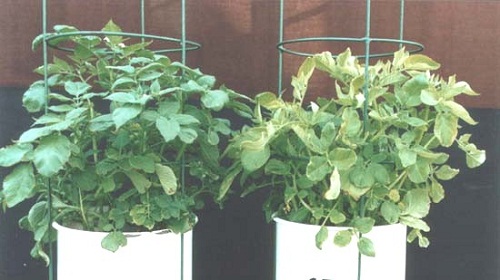
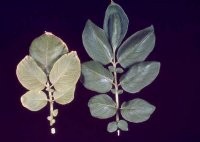
Iron
Under Iron (Fe) deficiency, the interveinal areas get chlorotic while the veins remain green. In cases of severe deficiency, the entire leaf is chlorotic. (Fig. 24). Iron deficiency symptoms firstly appear on the youngest leaves.
Figure 24: Characteristic Iron (Fe) deficiency symptoms
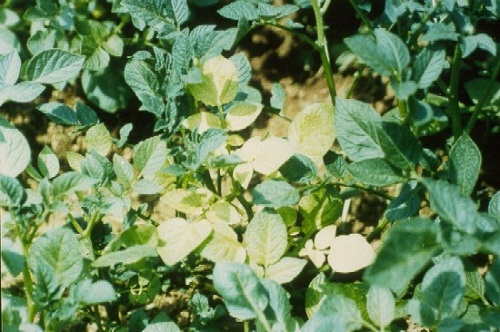
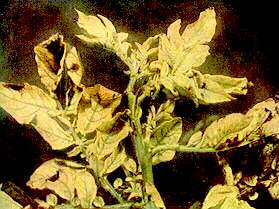
Boron
Boron (B) regulates transport of sugars through membranes, and also plays a key role in cell division, cell development and auxin metabolism.
Under condition of boron deficiency growing buds die, and plants appear bushy, having shorter internodes. Leaves thicken and roll upward; leaf tissue darkens and collapses. Brown necrotic patches appear on tubers, and internal rust spot are formed. (Fig. 25)
Figure 25: Characteristic Boron (B) deficiency symptoms
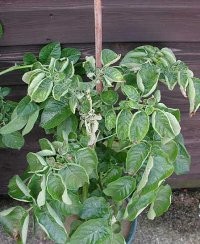
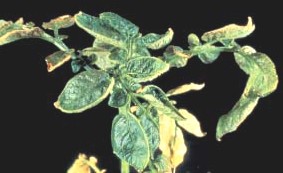
Copper
Under copper (Cu) deficiency young leaves become flaccid and wilted, terminal buds drop at flower bud development, and leaf tips become necrotic (Fig. 26).
Figure 26: Characteristic Boron (B) deficiency symptoms
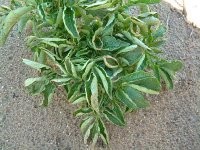
Zinc
Zinc deficiency symptoms: Young leaves become chlorotic (light green or yellow), narrow, upwardly-cupped and develop tip-burn. Other leaf symptoms are green veins, spotting with dead tissue, blotching, and erect appearance. (Fig. 27)
Figure 27: Characteristic Zinc (Zn) deficiency symptoms
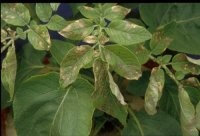
Manganese
Manganese (Mn) deficiency symptoms: black or brown spots on younger leaves; leaves yellowing; poor skin finish of the tubers (Fig. 28). Tubers are more easily damaged during lifting and storage.
Figure 28: Characteristic manganese (Mn) deficiency symptoms
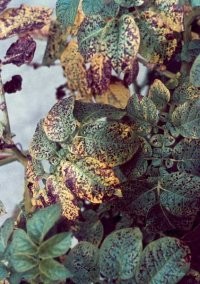
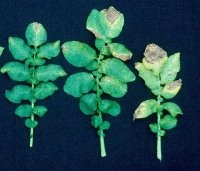
Table 8: Reference levels for each nutrient at foliar level:
| Nutrient (%) | Deficient | Low | Normal | High | Excessive |
| Nitrogen (N) | < 4.2 | 4.2-4.9 | 5.0-6.5 | >6.5 | |
| Phosphorus (P) | <0.23 | 0.23-0.29 | 0.3-0.55 | >0.6 | |
| Potassium (K) | <3.3 | 3.3-3.9 | 4.0-6.5 | 6.5-7.0 | >7.0 |
| Calcium (Ca) | <0.6 | 0.6-0.8 | 0.8-2 | >2.0 | |
| Magnesium (Mg) | <0.22 | 0.22-0.24 | 0.25-0.5 | >0.5 | |
| Sulfur (S) | 0.30-0.50 |
| Nutrient (ppm) | Deficient | Low | Normal | High | Excessive |
| Copper (Cu) | <3 | 3.0 -5.0 | 5.0 -20 | 30-100 | |
| Zinc (Zn) | <15 | 15-19 | 20-50 | ||
| Manganese (Mn) | <20 | 20-30 | 50-300 | 700-800 | >800 |
| Iron (Fe) | 50-150 | ||||
| Boron (B) | <15 | 18-24 | 30-60 | ||
| Sodium (Na) | 0-0.4 | >0.4 | |||
| Chloride (Cl) | 0-3.0 | 3.0-3.5 | >3.5 |
2.5 Plant nutrient requirements
Table 9: Nutritional requirements of potatoes
| Expected yield (ton/ha) | Removal by yield (kg/ha) | Uptake by whole plant (kg/ha) | ||||||||
| N | P2O5 | K2O | CaO | MgO | N | P2O5 | K2O | CaO | MgO | |
| 20 | 38 | 18 | 102 | 2 | 2 | 105 | 28 | 146 | 29 | 19 |
| 40 | 76 | 36 | 204 | 4 | 4 | 171 | 50 | 266 | 42 | 28 |
| 60 | 114 | 54 | 306 | 6 | 6 | 237 | 72 | 386 | 55 | 37 |
| 80 | 152 | 72 | 408 | 8 | 8 | 303 | 95 | 506 | 68 | 46 |
| 100 | 190 | 90 | 510 | 10 | 10 | 369 | 117 | 626 | 82 | 55 |
| 110 | 209 | 99 | 561 | 11 | 11 | 402 | 128 | 686 | 88 | 59 |
Need more information about how to grow potato? You can always return to the potato fertilizer & potato crop guide table of contents
Visit Crop Guide: Growing Potato to find out more about how to grow potatoes using Haifa products.
Related Articles:
NPK Fertiliser - Water Soluble Fertilizers
Informations about Foliar Feeding


